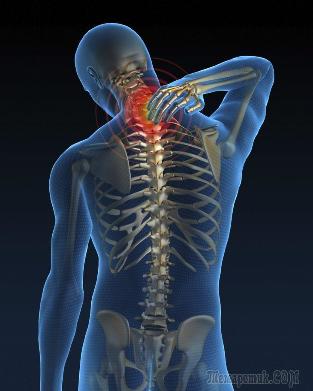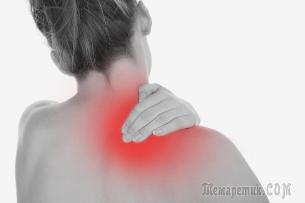Even about 30 years ago, osteochondrosis was associated exclusively with older people, whose joints become inactive and injured with every movement. However, times have changed. Today, more and more people are changing hard physical work to sitting at a computer, less and less monitoring the quality of nutrition, and more and more often facing osteochondrosis of the cervical spine. No wonder osteochondrosis is called the "disease of the century", and almost every person over the age of 25 encounters the symptoms of this disease.
This insidious disease, starting with uncomfortable pain in the neck area, very quickly leads to serious consequences in the form of hearing and vision impairment, as well as memory impairment up to its complete loss. This is why everyone should know the causes of osteochondrosis and consult a doctor in a timely manner in case of unpleasant symptoms of the disease. We will talk about them in this article.
Causes of cervical osteochondrosis
Paradoxically, all of our problems with the cervical spine begin in early childhood, or more precisely in elementary school, where the child's behavior worsens and scoliosis develops. It is at this point that the back support system of the head breaks down, in particular, from its thinnest and most vulnerable part - the cervix. The second major factor in cervical osteochondrosis, which originates in early childhood, is insufficient physical ability, in particular, weakness of the spinal muscles and the so-called muscular corset created to support the spine.
These are the two most important causes of the disease. All the rest are a heavy burden on the weakened spine, provoking the development of the disease in fairly young and healthy people. First of all, these include a sedentary lifestyle and lack of physical activity, in particular, work, which is associated with a long stay in one position. This is more typical for drivers and office workers who sit at the computer in shifts. All this is supplemented by overweight, which seriously increases the load on the back.

Other causes of cervical osteochondrosis are:
- past spinal cord injuries;
- metabolic disorders;
- hereditary predisposition;
- great physical activity;
- constant nervous tension and stress;
- abnormalities of the cervical spine;
- bad habits (holding the device by ear and shoulder)
Development of osteochondrosis
These unfavorable factors eventually lead to an increase in the load on the cervical spine. When you try to compensate for the excessive load on the neck muscles, their spasm occurs, which leads to impaired blood circulation in this area and reduction of metabolic processes. All this turns into the development of degenerative processes in the spine. First of all, the vertebrae begin to thin and converge, squeezing their contents (annulus fibrosus) out of the back. Such an extension in the language of doctors is called an extension.
In the case of extension, the annulus fibrosus still retains its integrity, but the extension is already squeezing the blood vessels and nerves that run along the spine and nourish the brain. Moreover, the converging and deformed vertebrae begin to squeeze the roots of the peripheral nerves, which leads to the development of the so-called "radicular syndrome", which manifests itself as severe pain in the back and neck. If you do not identify a problem (which will eloquently signal unpleasant symptoms) and do not start treating osteochondrosis, the fibrous ring will rupture and a spinal hernia will appear. In this case, there will be serious problems with brain nutrition.
Symptoms of cervical osteochondrosis
In its development, the disease goes through several stages, each of which has characteristic signs and symptoms. It should be noted here that osteochondrosis of the cervical spine differs from degenerative changes in other parts of the spine. The distances between the vertebrae here are minimal, and therefore even small degenerative changes cause unpleasant symptoms and lead to various complications.
1. Grade I osteochondrosis
This is the preclinical stage of disease development, in which the patient experiences mild pain and discomfort during head turns, as well as tension and fatigue in the neck and back during prolonged stay in one position (most often in a supine position). reduced). At this stage, osteochondrosis is perfectly treated by lifestyle changes, dietary adjustments and regular exercise.
2. Grade II osteochondrosis
At this stage, instability appears between the vertebrae in the neck. A person in this case faces severe pain that radiates to the shoulder, neck or arm. During tilting or twisting of the head, the pain increases significantly, as, due to a decrease in the distance between the vertebrae, the nerve endings begin to be damaged. The patient begins to get tired quickly, his performance decreases, distraction appears, forgetfulness and suffers from headaches.
3. Grade III osteochondrosis
With the onset of the third stage of the disease, the pain in the back and neck becomes even stronger, the mobility of the neck is significantly reduced and when the neck is turned, the crackling of the vertebrae can be heard. At night, the patient's fingers begin to numb (mainly the little finger and ring finger), so the person wakes up several times a night. Throughout the day, such patients have an uncomfortable weight on their hands. And even a brief conversation on the phone, in which a person is forced to hold the cell phone close to the ear, turns into tingling and numbness of the fingers. All of this indicates an increase in elongation, and possibly the appearance of a hernia in the cervical spine.
4. Grade IV osteochondrosis
In the final stage of the disease, the vertebral discs are destroyed, which cease to perform their functions and begin to be replaced by connective tissue. A patient in this condition may experience a movement coordination disorder, crazy noises and pulsation appear in the ears, headaches intensify, visual acuity and hearing loss. In some cases, numbness of the tongue may occur.
It should be noted here that due to the compression of blood vessels, blood flow to the brain is disrupted. Because of this, the patient develops neurotic disorders such as insomnia, irritability, nervousness and resentment, frequent mood swings, and inability to concentrate. Periodically there may be outbursts of anger or fear, melancholy attack and depression.
In the later stages of osteochondrosis development, severe vascular spasms can lead to the appearance of "flies" in front of the eyes, a feeling of instability on a hard flat surface, severe dizziness, migraine, nausea, vomitingand frequent fainting.

Disease Diagnosis
To identify the cause of the pathology, the patient describes to the doctor the unpleasant symptoms of his condition. After listening to the patient, the specialist sends him to one of the following search methods.
1. Radiography. Currently, this diagnostic method is considered uninformative, especially in the later stages of disease development.
2. Ultrasonic duplex scanning. This method is used in cases where a specialist assumes a violation of blood flow in the arteries that provide food to the brain. The study shows the speed of blood flow and determines if there are obstacles in its path.
3. CT (computed tomography). This method is more informative compared to radiography, as it not only detects the problem, but also allows you to determine the presence and size of hernias, albeit with difficulty.
4. MRI (magnetic resonance imaging). The most informative method for diagnosing osteochondrosis today, which allows you to see the bone structures, the presence of hernias and even the direction of their development.
Treatment of osteochondrosis
Let's say right away that to treat a problem as serious as osteochondrosis of the cervical spine, you should contact a neurologist. True, if the clinic has a vertebrologist, it is better to contact him first.
Osteochondrosis can only be treated in a complex way. The complex of methods used includes drug therapy, massage in the cervical area, exercise therapy, physiotherapy methods, as well as proper nutrition. Only a combination of all these methods will help to cope with the disease and normalize patient well-being.
Help with severe pain
In case of severe pain, doctors recommend taking medications such as Analgin, Baralgin or Tempalgin. When these medications no longer offer relief, you can switch to non-steroidal anti-inflammatory medications.
In a general sense, drug therapy includes the following tools:
- NSAIDs (non-steroidal anti-inflammatory drugs). These remedies relieve pain, relieve swelling and cope with inflammation of nerve roots.
- Chondroprotectors. Such drugs perfectly restore damaged cartilage tissue.
- Group B vitamins. They are needed to improve metabolic processes in nerve tissue.
- Muscle relaxants. These drugs work to reduce muscle spasms.
- Preparations that improve the rheological properties of blood. Thanks to such tools, the supply of oxygen and nutrients to the brain and nerve endings is improved.
It should be noted here that it is possible to achieve a tangible effect in the fight against osteochondrosis with the help of oils and tablets only if drug treatment is combined with other methods of therapy. Otherwise, the medication will only have a temporary effect.
Many specialists tend to treat osteochondrosis with injections in order to act quickly on nerve endings and save the patient from possible side effects when taking the pill. However, vitamins are best taken orally because vitamins are well absorbed by the body with any method of intake, but injections with them can be painful.
Physiotherapy treatments
Medication should be combined with physiotherapy methods. The most effective for this disease are:
- Electrophoresis (in combination with medication). In this case, the drugs penetrate the damaged vertebrae under the influence of an electric current.
- Ultrasound. This method of exposure allows you to remove the inflammatory process, relieve pain and improve metabolic processes in tissues.
- Magnetotherapy. This type of physiotherapy relieves bloating and pain.
- Laser therapy. It is an excellent method of combating inflammation and improving blood circulation.

Diet for osteochondrosis
Reconstruction of affected vertebrae also includes a special diet that normalizes metabolic processes in the body, prevents salt deposition, nourishes and restores cartilage tissue, and also strengthens the ligaments between the vertebral discs.
To achieve this, the following should be excluded from the patient's diet first:- alcoholic beverages;
- fatty and fried foods;
- spicy and very salty foods;
- strong soups;
- weaknesses and baked goods;
- strong tea and coffee;
- pickles and marinades;
- canned products.
The diet of a patient with osteochondrosis should consist of the following foods:
- lean meats and fish;
- low-fat milk, cottage cheese and kefir;
- butter (small amount);
- cereals and cereal soups;
- preferred meat, aspic from fish or meat;
- vegetables, fruits and berries;
- juices, fruit drinks, jellies and compotes.
When osteochondrosis is localized in the cervical spine, it is important to adhere to a drinking regimen, drinking at least 1. 5 liters of water a day. If you are overweight, then you need to think about how to get rid of those extra pounds, which put extra stress on your spine. It is advisable to skip meals 5 times a day in small portions.
At the same time, as can be seen from the list of allowed foods, the basis of the diet should be low-fat vegetarian soup, lean boiled meat, fish, seafood, vegetables and unsweetened fruits.
A menu item for the day will look like this:
- breakfast: cottage cheese, some apples, tea without sugar;
- lunch: roasted pears, some oatmeal cookies;
- lunch: vegetarian borscht, boiled chicken with vegetable salad;
- afternoon snack: dried biscuits and fruit juice;
- dinner: roasted fish with vegetables and sugar-free tea.
Exercise therapy for osteochondrosis
Physical education gives excellent results in the treatment of osteochondrosis, although you can do cervical spine gymnastics only during the recovery period. Important it is important here that during the process of massage or gymnastics the patient does not experience discomfort and pain.
Here are some of the most effective gymnastic exercises aimed at strengthening the cervical muscles and improving blood circulation in this area.
Exercise # 1
Lying on your stomach and resting your hands on the floor, slowly raise your head and torso so that your back is straight. Hold this position for 1 minute, then return to the starting position. The element is repeated 2-3 times.
Exercise # 2
Lying on your stomach and arms outstretched along your body, raise your head slightly and start turning it first to the right, trying to touch the floor with your ear, and then to the left. Make 6 turns in each direction.
Exercise # 3
Sit on the floor as you inhale, lean forward, trying to reach your chest with your chin, and as you exhale, return to the starting position and tilt your head back. Repeat the element 10-15 times.
Exercise # 4
Place your palms on your forehead and try to press your head firmly. At the same time, as you strain your neck muscles, resist your hands, not allowing your head to tilt. Hold the pressure for 20-30 seconds, then lower your arms and relax. Repeat the element 2-3 times, and then repeat the exercise in the opposite direction, bringing the gripped hands to the back of the head.
Exercise # 5
Start slowly turning your head to the right and left, trying to look behind your back. Make 10 turns on each side.

















































